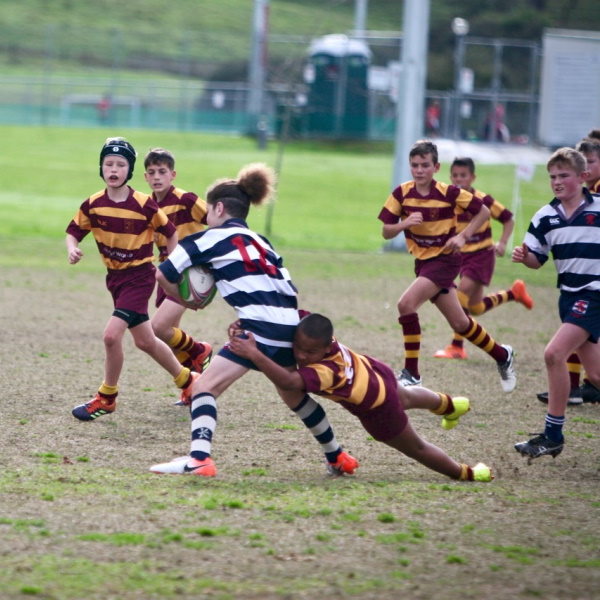
J6-4
Tackling 101
The first-year of tackle is a nervous season. There is the hope that they get into it and that they don't get hurt and put off. Then there is the reality that there are very few tackles actually made.
- Categoryskills
- Last UpdatedSep 2021
J6 is the youngest tackle grade and we want every kid to play in this grade because everyone in the grade is new to tackle and thus on an even playing field. We want to ensure kids develop a good tackle technique at this level as it will serve them well and keep them safe.
Where to start?
Funny enough, the best place to start is with being tackled and falling. This is what kids are most afraid of and where the 'donks' are more likely to happen. At this level, we want to teach them to hold onto the ball and keep it close to the chest. This creates tension and strength around the upper body. We also want to teach them to fall forward with the tackle. We don't want them stopping and being driven back. These two things help prevent falling injuries.
The best option is to take the fear of falling away. A crash mat does the job here. First have them practice running and diving onto the mat, keeping the ball tight into the chest. Next, the coach acts as the tackler. On their knee's have the player run, full speed, into the coach who makes the tackle. Once the players have this going well and enjoying it you can then start having the players be the tackler.
If kids are afraid of falling, this makes it very difficult to have other kids practicing tackling on them. They will often run up and then just stand there or move sideways. They often make it difficult for the tackler to concentrate on the actual tackle technique because the ball carrier is being awkward.
Main Points
- The tackler is on their knees. This helps put them at a better height to understand where they should be for tackling.
- Their hands are up and they are watching the ball carries thighs.
- Make contact with the top of the shoulder.
- The outside arm wraps quickly to join the other arm and they squeeze together. At the same time rotate the body and land on top of the ball carrier.
The most important point. Tackle with the top of the shoulder. Not the hands, not the arms, chest or face. The top part of the shoulder. This is the strongest and safest point to make a tackle.
Get all the kids comfortable at this level. They should be running in strong and tackling with confidence. Practice both shoulders.
Time to stand up
Before the first game, you want to get them practicing tackling on their feet. Most likely you may run a combo of the first drill and this one until eventually you just use this one.
The main difference when on your feet is that we need to teach the kids to move forward in the tackle. Moving forward into the tackle makes it a much easier task than allowing the opposition to run at you. But otherwise, we continue the same points. Look to break the skill into three learning phases. The hit. The hit and drive. The hit, drive and slam.
You can do this with the ball carrier carrying the ball. The other is to use a hit shield to offer better protection for when the kids get more confident and want to start really running in and hitting. When you do, have the players hold it high with arms out in front. Avoid holding the hit shield straps as this doesn't represent the position the player will be in when they are tackled.
Main Points
- Hands up and eyes on thighs.
- Move towards the ball carrier targeting the thighs with the top of the shoulder.
- Wrap the arms and drive. The arms wrap and squeeze tight. The legs continue to drive forward using short fast steps.
- Use the legs to drive the opponent left or right depending on the shoulder used and as that is happening twist the body so they land on top.
An important point to watch out for is any 'bowing' of the back. This is more obvious in taller players. Watch out for this. Get them to raise the eyes up and drop the butt down when tackling.
Time to get rid of the mats? Nope!
For J6, J5 keep using the mats. You will have a variety of kids, big, small, confident and timid. It is more important that they are confident they won't get hurt and develop excellent technique and enjoy it before live tackling is done. Don't rush into that. Will they freak out when they come to a game? They may a little, but during training, they will experience the ruff and tumble of rugby through other games and drills. In the game, they will have something they don't often have at training, adrenaline. Combine that with an effective tackle technique and they won't even notice.

